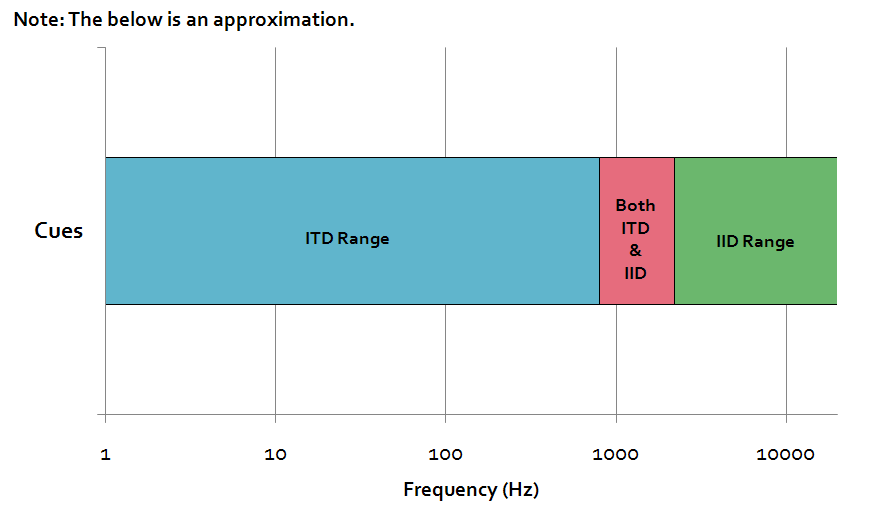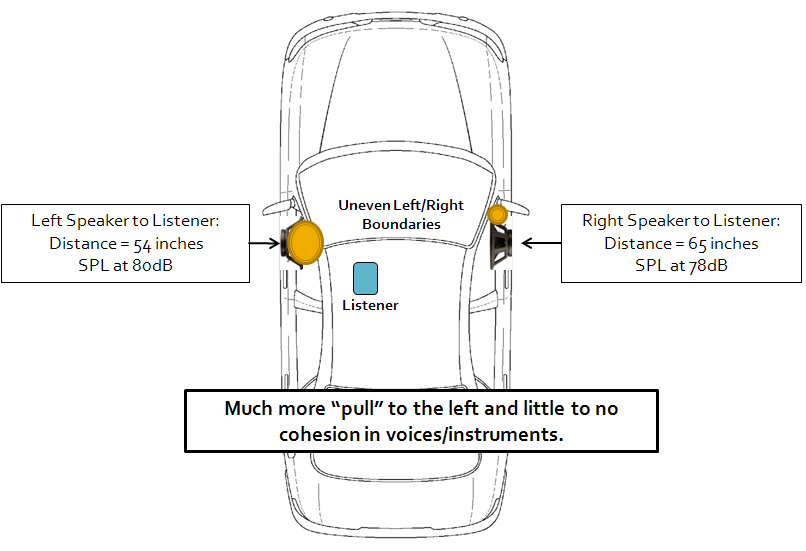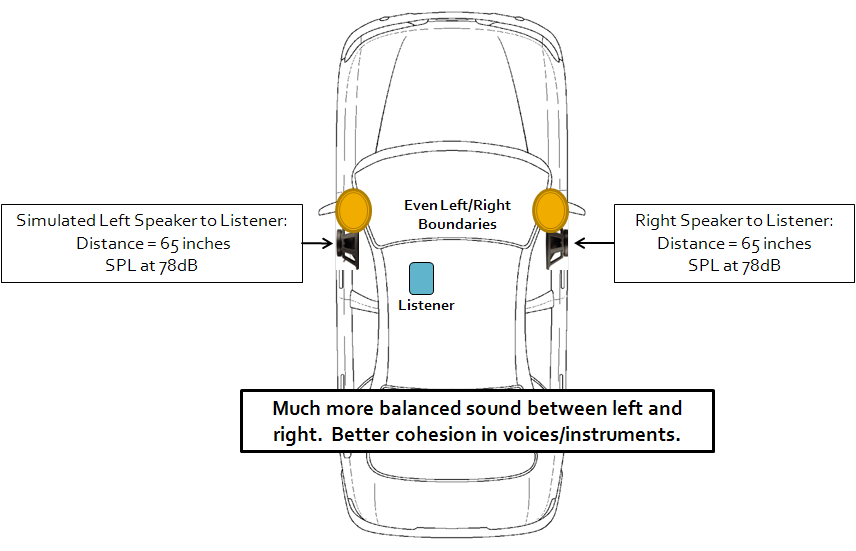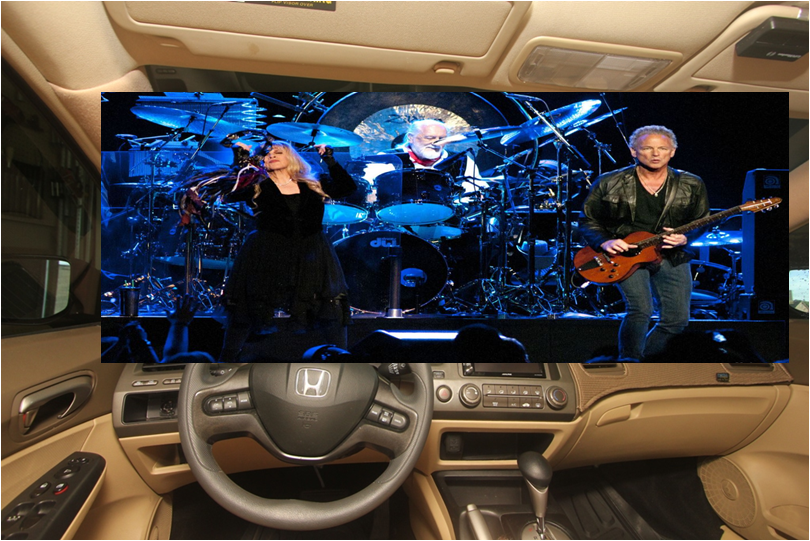Crossovers:
Crossover Point/Slope should be evaluated as a set. Using just a number and a willy-nilly slope isn't exactly a good method to use. There needs to be some reason for setting these values. The frequency dictates at which point you want to start rolling the speaker off. The slope will dictate not only absolute and relative phase but also attenuation.
Crossovers are made of both the frequency and the slope you use. So, let's look at that...
Crossover Frequency:
Namely, there are four aspects I am considering for low/high pass crossover values. Each of these are discussed in the driver basics section above but I will recap.
- Beaming. Where does the driver's high frequency response begin to separate from on/off-axis? Using the Polar Response and Beaming reference above, you can see some of the math behind it and reasons as well.
- High frequency breakup. All speakers begin to break up at some point. It's just an effect of the cone material and shape. Typically drivers don't break up until about an octave or so above their beaming point. Some drivers control break-up better than others through cone design. What you want to avoid is the area where the break up is severe enough to be heard outside of the crossover point. BUT, since this breakup usually occurs above beaming, you should be crossing before breakup occurs.
- Low frequency distortion. You should know what I mean here... take a tweeter for example. If you cross a tweeter at 500hz, odds are, you're going to get all sorts of distortion and ultimately fry it. The general rule of thumb seems to be to cross the tweeter at 2*Fs (Fs=resonant frequency of the voice coil). BUT, this isn't a one-size-fits-all solution. Some drivers may have a low Fs but may not be well suited for a low crossover (ie; some drivers have an Fs of 700hz but I wouldn't run them at 1400hz full tilt with any slope). The key here, really, though is matching the dispersion pattern as well as you can to the driver before it. In the case of a 3" mid which beams at 2.5khz, you'd want to cross your tweeter somewhere in this area to keep from having a null at the crossover point, not fixed by any phase/polarity changes. Again, see the post I mentioned in #1, above.
- Natural Rolloff. On the low frequency end, the driver rolls off naturally. This is dictated by the Qts and Fs (the Qts dictates how much the rolloff is and Fs tells you at what frequency it occurs). These 2 pieces of information can be found in an impedance plot. Most people will try to set their crossover point and slope to essentially follow that same natural rolloff so you combine both the acoustic rolloff of the driver with the electrical crossover and don't alter the phase severely.
Crossover Slope:
The slope you use depends on the following:
- Level of attenuation needed.
This should be self-explanatory. Basically, the steeper the slope, the faster the rolloff. - Phase:
- I can't say enough how non-trivial this is. There's the "set it and forget it" method which can be made to work or there's the "spend a lot of time on it until you get it as good as you can" which I propose. The latter option will save you a lot of headaches in the future.
- Think of two sine waves. If both are in phase, they play together and the amplitude is increased. If they are out of phase by 180 degrees, they cancel each other out. Your goal at the crossover is to essentially allow one speaker to 'carry' in to the other, without evidence or calling attention to anything in the crossover region. You want in phase sine waves... for a lack of better analogy.
What you will HAVE to do is EXPERIMENT. Using the above crossover frequency info, pick a point that makes sense to start with. From there, change the slope of one driver with respect to another or even both drivers. Take notes. Which settings sounds better? What happens when you change the polarity of the tweeter but leave the midrange polarity the same? What happens if you change the slope of the midrange from 24dB/Octave to 12dB/Octave? Then try flipping it's polarity.
FWIW, I typically shy away from anything less than Linkwitz-Riley 12dB/octave (LR2 - "2" for second order). The reason why is pretty simple: power handling. If you know me, you know I like some volume. Then there's the case of out of band EQ'ing that may be necessary and if you don't have this ability with your DSP, it's a problem. A steeper slope keeps less information from overlapping. Especially the high frequency content you don't want playing due to beaming and breakup. And for those convinced that low order is the best way to go in a time domain case, keep this in mind: although a 6dB/octave butterworth has no group delay, it doesn't mean your summed response won't result in such. What you care about is the total response. Not just a resistive load single crossover. 
There's no guaranteed slope or crossover point that will work for you. The reason why is because the crossover network that works best is dependent on the characteristics of a single driver (breakup, natural rolloff, distortion) AND the crossover point/slope of the driver you are mating it to!
You will have to experiment. You can use your ears or a mic. I think it's useful to try using your ears as it makes you a more attentive tuner. The mic can do a lot of things great, but it can also mislead you as well. So, you have to really listen in between adjustments made via mic. One thing I suggest is to narrow the best settings down to a few. Then from those, listen. Use pre-sets if you can and switch back and forth between them.
I also recommend using correlated pink noise to help you set your crossovers. The CD link I provided in the Resources section has this.
Mute everything but the mid and tweeter (or whatever it is you're setting the crossovers on) and listen to them as a pair while you alter the crossover settings. Listen for the sound to be fuller and as one. If you hear more of one driver than another keep in mind this may be simple levels, which we will address later. For now, focus on trying to listen for cohesion at the crossover point, though. If you're crossing your mid and tweeter at about 3khz, don't worry about what's going on at 500hz or 10khz. Pay attention to the 2-4khz range and see how that area changes as you adjust your crossovers' settings. Something else you can try, which is what I do, is to use pink noise 'tones' at the frequency around the crossover point. This is really helpful with time alignment which I'll get in to later as well.
Something else I've noticed is when the two drivers are out of phase, I'll hear a phantom image in front of me; away from the drivers I'm tuning. It's a total mind trip.
Finally, your goal is to get it as close as you can. It likely won't be perfect, because most car installs require a large delta between drivers and thus there will most likely be lobing (this is again why #1 in the Crossover Frequency section is important) but what you should find is after spending some QUALITY time doing this, you'll have a much fuller soundstage and more cohesion between drivers. Time alignment can be used to further tweak this. That's for later, though. Right now, focus on getting the crossover point and slope as dialed as possible between each set of drivers.
Additional Crossover Notes::
While the previous section focused on a single driver characteristics and understanding them, the import factor is the implementation of a driver in a system… with other drivers.
Good power response should be your goal but it’s not easy.
- For example, mating a 1” tweeter to an 8” woofer isn’t as easy as mating a 1” tweeter to a 6” woofer. Why? Because the tweeter doesn’t have to cross as low to match the 6” woofer’s dispersion. If you tried to cross the tweeter to match the 8” woofer, you’d increase the tweeter non-linear distortion considerably. Conversely, if you increased the 8” driver’s low pass filter you’d likely exceed it’s beaming point and the dispersion wouldn’t match between the mid/tweeter.
Let's look at another example using a typical 2-way setup:
- A typical 2-way setup consists of a 6.5” woofer and ĺ” tweeter. The following is a generic analysis based on typical drivers:
- ĺ” Tweeter Crossover:
- THD reaches 3% at 2khz (raw driver)
- 6.5” Woofer Crossovers:
- Most 6.5” woofers with moderate linear throw (3-5mm one-way) have 3% THD by 80hz.
- Fs/Qts will drive the enclosure which drives Qtc which drives the crossover as well. A lower value Qtc means less cone control and more attention should be placed here to not damage the suspension or fry the voice coil.
- Beaming will occur by about 1.2khz with an effective diameter of 6”. Based on this, you can assume a 2khz would suffice to keep the driver’s on and off-axis response fairly well matched. Much higher above this and the separation is more severe.
Therefore, a nominal crossover point between mid and tweeter in this generic example would be in the 2khz – 3khz range, in order to mitigate woofer breakup and beaming but also to lessen tweeter distortion. Crossing the woofer above 80hz on the low end will help mitigate it’s distortion at higher volumes.







 Reply With Quote
Reply With Quote





 After some playing around you found that the problem really is due to a reflection from your right speaker. You wanted to believe you were fixing the problem and so you did… but you really didn’t. Another potential problem could be the issue at 1khz is due to a reflection; a harmonic of 500hz is causing the issue and if you wanted to fix the root of the problem, you needed to adjust 500hz. Not 1khz.
After some playing around you found that the problem really is due to a reflection from your right speaker. You wanted to believe you were fixing the problem and so you did… but you really didn’t. Another potential problem could be the issue at 1khz is due to a reflection; a harmonic of 500hz is causing the issue and if you wanted to fix the root of the problem, you needed to adjust 500hz. Not 1khz.







